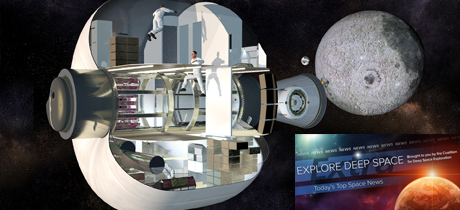In Today’s Deep Space Extra… Advancements in space continue despite difficult times due to global coronavirus pandemic.
Human Space Exploration
NASA perseveres through pandemic, looks ahead in 2020, 2021
Coalition Members in the News – Astrobotic, Boeing, Dynetics
Parabolic Arc (8/13): Activities ahead include the first scheduled commercial crew launch to the International Space Station (ISS). Planned for late September, SpaceX, if certified following its successful two month DM-2 test flight, will launch four astronauts to the Space Station, effectively doubling the number crew available for scientific and technology activities in the U.S. segment. The OSIRIS-Rex mission is to obtain a sample of the asteroid Bennu on October 20. The Michael Freilich Sentinel-6 mission is to launch in November to monitor sea levels. And a highly anticipated ground test firing of NASA’s Space Launch System (SLS) rocket is planned for late this year at the Stennis Space Center.
Sierra Nevada makes progress on LIFE inflatable habitat for lunar, Mars missions
Coalition Members in the News – Aerojet Rocketdyne, Dynetics
Americaspace.com (8/13): Working under a NASA Next Space Technologies for Exploration Partnerships (NextSTEP-2) initiative, Sierra Nevada Corp. is developing an expandable commercially launched deep space habitat for four astronauts with a pressurized volume perhaps one third that of the International Space Station (ISS).
Researchers built a “gravity suit” to keep astronauts healthy
Futurism.com (8/13): In a development effort led by personnel from the University of California San Diego and published in Frontiers in Physiology, researchers describe a new garment for astronauts that could help to counter the ill effects of weightlessness, including muscle atrophy and the pooling of blood around the brain. Developed with help from NASA researchers, the space suit is intended primarily for future commercial astronauts as well as those assigned to long missions to Mars.
Space Science
Fastest star ever seen is moving at 8% the speed of light
Universetoday.com (8/13): S62 is the designation for the star closest to the massive black hole, Sagittarius A, at the center of the Milky Way galaxy. Twice the mass of the sun, S62 circles Sagittarius A once every 10 years. When it’s closest to the black hole, S62 is moving at 8 percent the speed of light, the fastest a star has been observed.
The bizarre dimming of bright star Betelgeuse caused by giant stellar eruption
Space.com (8/13): Look up at the constellation Orion, where the large star Betelgeuse shines brightly at the shoulder. However, nearly a year ago, it began to dim, puzzling astronomers who thought because of its brightness the dimming indicated Betegeuse was about to explode. With the help of the Hubble Space Telescope, they determined the dimming was due to dust ejected by the star. The brightness returned in May. At 500 light years away, the star’s near term fate is unclear.
Op Eds
Peace of the worlds
SpaceNews.com (8/12): Few, perhaps, imagined that the COVID-19 virus would emerge with a World War III threat status. University of Colorado engineer and scientist Daniel Baker and Michael McGrath compare the rise to the aliens from H.G. Wells’ classic novel “War of the Worlds.” However, the coronavirus threat in some ways is bringing a divided planet together. Perhaps, the recent successful launches of NASA, Chinese and Indian missions to Mars offer a much desired taste of good news, they write.
Other News
The U.S. Department of the Air Force, Boeing X-37B team to receive the 2019 Robert J. Collier trophy
Coalition Member in the News – Boeing
National Aeronautic Association (8/12): The U.S. Air Force X-37B team has been selected to receive the Robert J. Collier Trophy for 2019 for its success in developing and operating the autonomous, reusable orbital space plane over 5 missions spanning 2,865 days in space for technology development. “The ability to test new systems in space and return them to Earth is unique to the X37B and enables the U.S. to more efficiently and effectively develop spacepower to maintain superiority in the space domain,” said U.S. Space Force Chief of Space Operations, Gen. John “Jay” Raymond. A date for the trophy presentation has yet to be determined.
Northrop Grumman completes ground test of solid booster for ULA’s Vulcan Centaur
Coalition Members in the News – Northrop Grumman, United Launch Alliance
SpaceNews.com (8/13): Northrop Grumman achieved a milestone Thursday with a ground based qualification test firing of the segmented solid rocket booster that will provide thrust for the new United Launch Alliance (ULA) Vulcan Center launch vehicle. The 90 second test unfolded at Northrop Grumman test facilities in Promontory, Utah. The inaugural launch is planned for in 2021.

